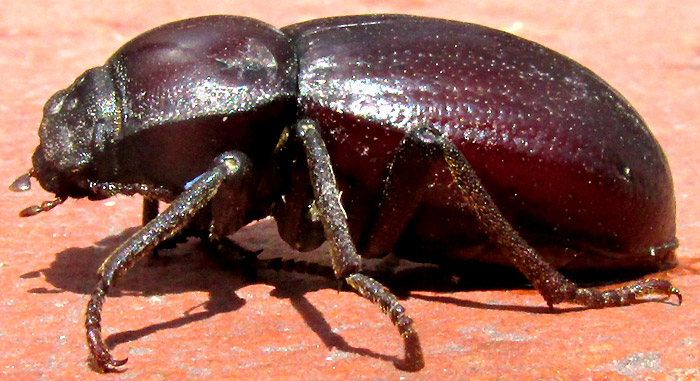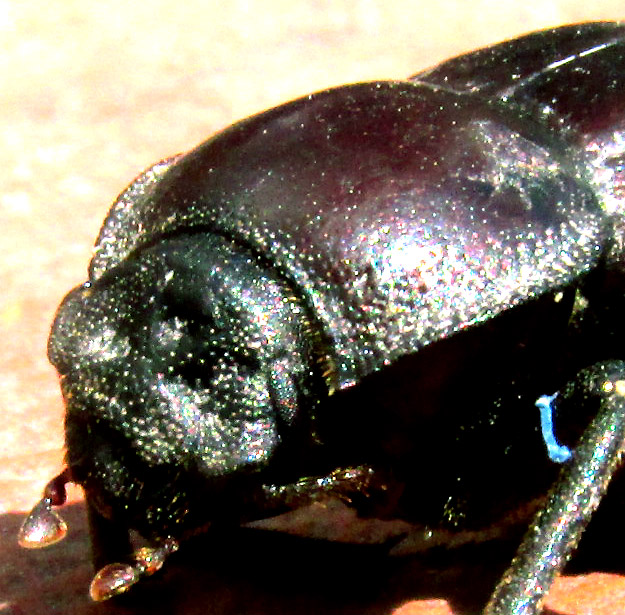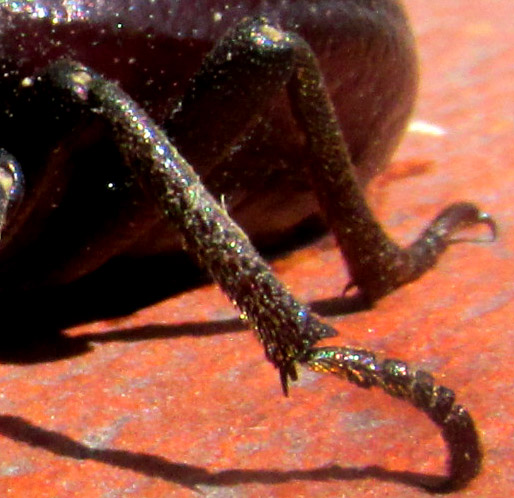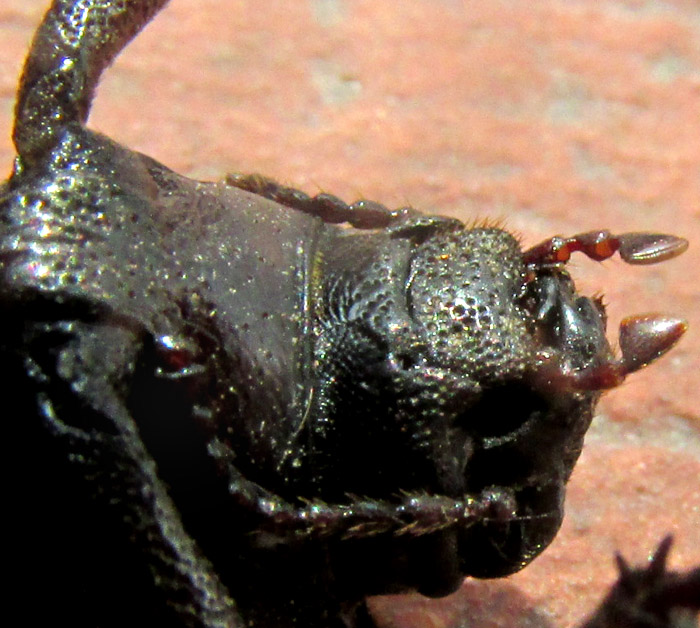Excerpts from Jim Conrad's
Naturalist Newsletter
Entry dated August 11, 2023, issued from near Tequisquiapan, elevation about 1,900m (6200 ft), Querétaro state, MÉXICO
(~N20.57°, ~W99.89°)
WATERBUG? MACRELMIS? ELMIDAE?

The above beetle was found drowned in a plastic bucket half filled with water serving as a dog's water bowl, on the front patio of a home behind tall stone walls, at the edge of a small village with a dry gully with mesquite trees along its banks, and overgrazed ranchland beyond. Usually I ignore such finds, thinking I'll never be able to identify such nondescript insects, but I'd been reviewing insect anatomy and wanted to give it a try.

The whole body was covered with what looks like tiny indentations in the above photo, but which some authors call granules, often referring to lines of granules, though sometimes they're not in lines. The beetle's compound eyes are exceptionally small. The two flattish, brown items in the image's lower, left corner are maxillary palps -- sensing appendages associated with the insect's mouthparts. Only a little of an antenna running along the beetle's side is visible. The blue thing must be a shred of plastic from the bucket. On the large body part occupying most of the top of the picture, the pronotum, note that the sides bend upward and outward. Hairs appear spottily.

At the above picture's lower, right, the curved tarsus is 5-segmented. The leg part above it, the tibia, is club-shaped and tipped with spurs. Two tarsal claws bend inward, hidden in shadow, on the most visible leg, but on the back leg project outward. The leg is mostly hairy.

This beetle's rear part, the abdomen, has only 5 segments. Note how the first one, toward the beetle's front, extends up between the two back legs' bases.

In the above picture of beneath the beetle's head, the antennae are better seen. Apparently they consist of eleven segments, which closer to the head are hairy, while the outer ones aren't. The beetle's biting and chewing mouthparts are much smaller than most beetle's, hardly visible between the maxillary palp bases.
The beetle order, Coleoptera, with around 400,000 described species, is the largest of all orders, constituting about 40% of all known insects and a quarter of all known animal species. Since beetles are poorly known in Mexico, to determine the above beetle's family I could find no better guide than P.M. Choate's online 1999 "Dichotomous Keys to Some Families of Florida Coleoptera." I was led to the Riffle Beetle Family, the Elmidae. J.H. Epler in his 2010 identification manual The Water Beetles of Florida refers to the Riffle Beetle Family as "the most truly aquatic of our water beetles," with all larvae and most adults aquatic, usually living in rapid, cool streams.
In this dusty, semiarid scrub zone in the midst of an enduring, intensifying drought, I thought I'd made an ID mistake. Accepting that a beetle might fly a long way to end up diving into a half filled bucket of water, surely it wouldn't drown in it. However, I've read that some of these aquatic beetle species, though feeding on submerged decaying plants, algae and the like, can't swim and can drown if there's nothing floating on the surface to hang on to, or irregularities at the bank they can grasp and pull themselves from the water, though it's unclear which species they were referring to.
I tried several identification keys and always landed on the Riffle Beetle Family, or else the very closely related family, the Dryopidae. The University of Michigan's Animal Diversity Riffle Beetles Web page describes most riffle beetle antennae as usually slender and slightly clubbed (like ours), adding that "... this distinguishes them from species in an otherwise-similar family, the Dryopidae." Those features seem weak ones for separating families. My impression is the world of aquatic beetles is exceptionally poorly known and documented. In the 2018 online work by María Inês Passos and others entitled "Families Droypidae, Elmidae, and Psephenidae," it's suggested that the Dryopidae rarely has been studied in the New World tropics "... perhaps due to the difficulty in collecting specimens in the flow of streams and rivers." That seems to be true of all the water beetle families.
Various routes of identification, including simply doing image searches among untold thousands of species, frequently brought me not only to the Riffle Beetle Family, but also to the riffle beetle genus MACRELMIS. Because this part of the Phylogenetic Tree of Life is so imperfectly known, and I can't find anything exactly like our beetle, I feel obligated to post this web page under the keywords "Elmidae" and "Macrelmis" -- so future researchers can find our pictures.
In July of 2001 the beetle known as Alfredo 3943 was collected and stored at the University of Queréto, and identified by "W. Shepard B." as Macrelmis sandersoni. Its collection coordinates center in the semiarid scrub a few kilometers west of here. The single picture of Macrelmis sandersoni I can find on the Internet -- a mounted specimen -- looks very much like our bucket one, except that between the rounded part of its pronotum and the upturned sides, there's a kind of suture, or thin line, that's totally missing on our beetle. Our beetle must not be Macrelmis sandersoni. Newer studies from across the world dealing with the genus Macrelmis focus largely on microscopic anatomical details of the genitalia.
To the future researcher: Good luck, and I hope you're enjoying your sleuthing as much as I have.